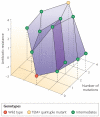Mechanistic approaches to the study of evolution: the functional synthesis
- PMID: 17703238
- PMCID: PMC2488205
- DOI: 10.1038/nrg2160
Mechanistic approaches to the study of evolution: the functional synthesis
Abstract
An emerging synthesis of evolutionary biology and experimental molecular biology is providing much stronger and deeper inferences about the dynamics and mechanisms of evolution than were possible in the past. The new approach combines statistical analyses of gene sequences with manipulative molecular experiments to reveal how ancient mutations altered biochemical processes and produced novel phenotypes. This functional synthesis has set the stage for major advances in our understanding of fundamental questions in evolutionary biology. Here we describe this emerging approach, highlight important new insights that it has made possible, and suggest future directions for the field.
Figures





References
-
- Elena SF, Lenski RE. Evolution experiments with microorganisms: the dynamics and genetic bases of adaptation. Nature Rev. Genet. 2003;4:457–469. - PubMed
-
- Losos JB, Jackman TR, Larson A, Queiroz K, Rodriguez-Schettino L. Contingency and determinism in replicated adaptive radiations of island lizards. Science. 1998;279:2115–2118. - PubMed
-
- Powers DA, Lauerman T, Crawford D, DiMichele L. Genetic mechanisms for adapting to a changing environment. Annu. Rev. Genet. 1991;25:629–659. - PubMed
-
- Wourms MK, Wasserman FE. Butterfly wing markings are more advantageous during handling than during the initial strike of an avian predator. Evolution. 1985;39:845–851. - PubMed
Publication types
MeSH terms
Substances
Grants and funding
LinkOut - more resources
Full Text Sources
Miscellaneous

